Click on this link to watch a 4 minute video on backyard chicken raising in general, with a few specifics about the DFW area. Enjoy!
Dan (the interviewee) will possibly be giving Chicken 101 talks at the Coop Snoop as well!
Click here to view clip
Sunday, August 28, 2011
WFAA Interview on Backyard Chicken Keeping
Wednesday, August 24, 2011
When Ya Gotta Go
This article is taken from the February 16th posting of Wormspit.com. They have graciously allowed us to re-post. The original post can be found here.
When Ya Gotta Go
Monday, I was working on cleaning out the chicken coop. Rawnell decided that she needed to lay an egg. In spite of the whole top of the coop being open, she walked up the plank and plopped herself on the nest. I respectfully left her alone; a girl needs some privacy for these things.
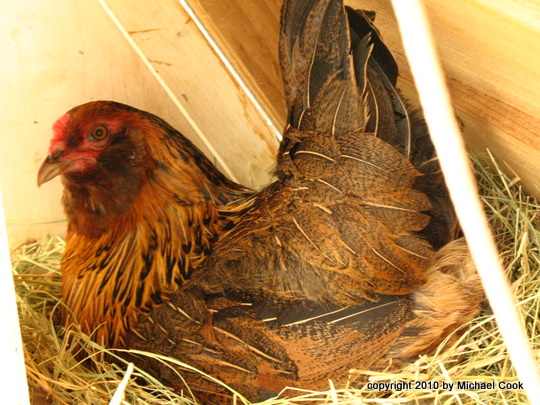
Apparently it was a false alarm, though - after a few minutes, I went back outside, and she was out pecking with the other chickens. I got back to the business of shoveling chicken poo.
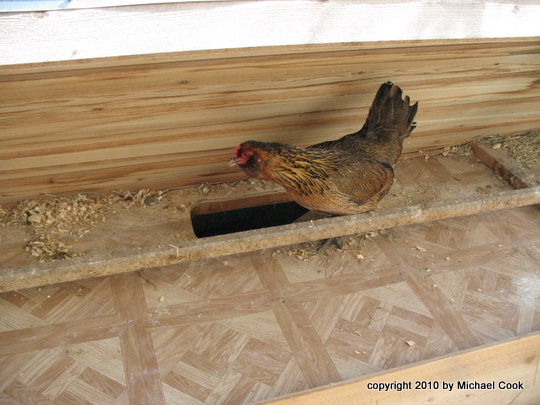
I got the coop cleaned out - the linoleum flooring makes it easy! An area on one side was a little wet, and needed to air-dry, but Rawnell decided it was egg time again. She walked around cackling. Usually, hens make this noise after they've laid an egg, but you also get it sometimes if they're distressed or annoyed.
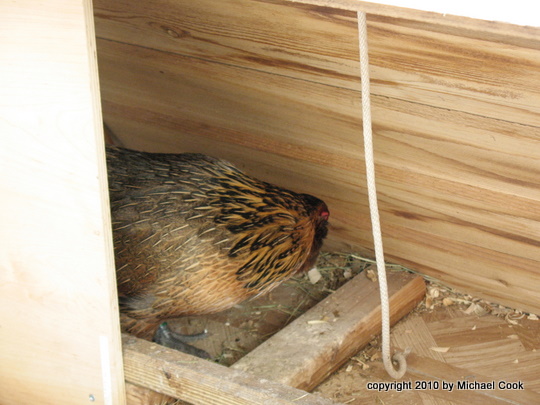
The nest box doesn't look right with no hay in it. She walked up the ramp, around the top of the coop, and back down, several times. "Where's the nest with the hay in it? I swear I left it here just a minute ago..."

She tried looking at it from a different angle. This didn't work.

I put the hay and the shavings back in, and she settled down in a nest box on the opposite end from the usual one. Of course, with seven hens, they ALL decide that they have to use a single box. It makes for convenient egg-collecting, but sometimes causes a bit of a traffic jam.
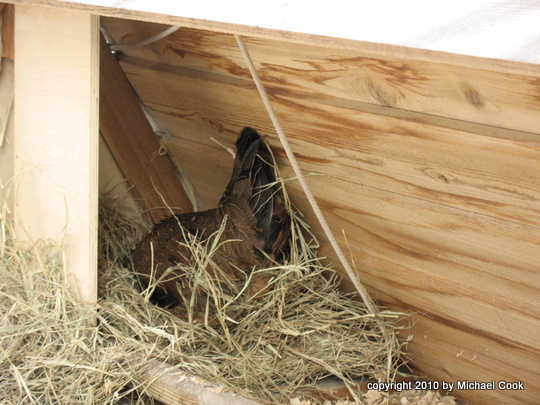
She sat (and I left her alone) for probably ten minutes, before she decided that box just wasn't going to work. She was agitated and fidgety, and finally got up and crossed the coop to the usual box. She fussed and fluffed and rearranged. I gave up on putting the coop back together, and went inside.
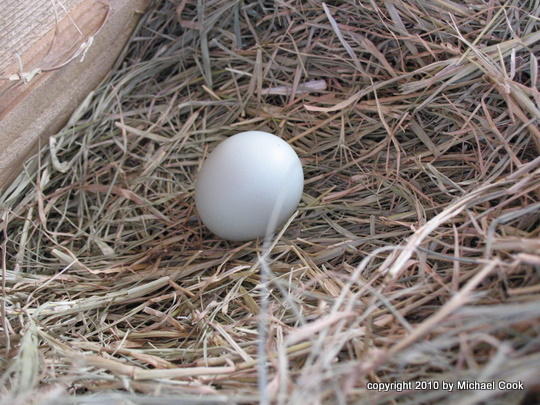
After folding a load of laundry and coming back out, I found one perfect, beautiful blue egg. -Michael
When Ya Gotta Go
Monday, I was working on cleaning out the chicken coop. Rawnell decided that she needed to lay an egg. In spite of the whole top of the coop being open, she walked up the plank and plopped herself on the nest. I respectfully left her alone; a girl needs some privacy for these things.

Apparently it was a false alarm, though - after a few minutes, I went back outside, and she was out pecking with the other chickens. I got back to the business of shoveling chicken poo.

I got the coop cleaned out - the linoleum flooring makes it easy! An area on one side was a little wet, and needed to air-dry, but Rawnell decided it was egg time again. She walked around cackling. Usually, hens make this noise after they've laid an egg, but you also get it sometimes if they're distressed or annoyed.

The nest box doesn't look right with no hay in it. She walked up the ramp, around the top of the coop, and back down, several times. "Where's the nest with the hay in it? I swear I left it here just a minute ago..."

She tried looking at it from a different angle. This didn't work.

I put the hay and the shavings back in, and she settled down in a nest box on the opposite end from the usual one. Of course, with seven hens, they ALL decide that they have to use a single box. It makes for convenient egg-collecting, but sometimes causes a bit of a traffic jam.

She sat (and I left her alone) for probably ten minutes, before she decided that box just wasn't going to work. She was agitated and fidgety, and finally got up and crossed the coop to the usual box. She fussed and fluffed and rearranged. I gave up on putting the coop back together, and went inside.

After folding a load of laundry and coming back out, I found one perfect, beautiful blue egg. -Michael
Monday, August 22, 2011
Saving Money on Chicken Feed
This article is taken from the August 2011 newsletter of Robert Plamondon, a chicken-keeper in Oregon:
Here are some ways to get results:
Save Money on Chicken Feed
Are you as tired as everyone else of paying record high prices for feed? What can you do about it? Whatever you do, don't under-feed your chickens! They'll stop growing and laying, and, anyway, it's not nice!Here are some ways to get results:
- Buy high-quality feed from a reputable dealer High-quality feed is expensive, but it's a bargain compared to low-quality feed. Chickens have a high metabolism and and a low tolerance for contaminated feed and low-quality feed, so ingredients that pigs or steers could tolerate can really hurt your chickens. The only safe course of action is to give your chickens as much high-quality feed as they want. Don't compromise on this. High-priced feeds tend to provide more value because cheap feeds are bulked up with cheap ingredients like mill run—ingredients with relatively low feeding value and that the chickens don't like much, anyway. So always keep one feeder full of the highest-quality feed around.
- Supplement with low-cost whole grains. In a second feeder, offer whole grains of whatever kind you can get cheap. It's not uncommon to be able to buy whole grain by the sack for half the price of chicken crumbles or pellets. Whole grains keeps for a long time without going bad and are often available for low prices from local farmers or grain wholesalers. Here in the Corvallis area, Venell Feed sells grain for much lower prices than feed stores. We keep feeders full of whole corn for our layers all the time. If whole wheat is cheaper than chicken feed in your area, it can be used with chickens of all ages. Oats and barley are hard for chickens to digest when they're younger than 6-8 weeks old, but are okay afterwards. Cracked grains don't keep anywhere near as well (when I use it, it often goes moldy on me), and a lot of places use finely cracked grains that chickens don't like. Chickens prefer whole grains and coarsely cracked grains.
- Supplement with whatever else you can find. If you have something else the chickens might like, go ahead and try it! The trick is to never take away their chicken feed. Chickens like variety and they like fresh feeds better than chicken feed, so they'll give alternative feeds every consideration. Our chickens have proven ravenous devourers of leftovers, apples, vegetables (though you need to cut vegetables with thick skins in half so they can get at the insides), popcorn, grass clippings, milk, and, really, just about everything imaginable. But they know what's good for them and will ignore feeds that don't have anything they need or that have gone bad. Sure, if you stake away their chicken feed, you can force them to eat stuff that's bad for them, but what's the point in that? The key is to trust them to eat what's good for them. If they turn their noses up at something you offer them, take it away.
- Supplement with range. Chickens like foraging on grass range and can get a lot of vitamins and proteins from bugs and, more importantly, fresh green plants. Most of the time, though, the available forage is very short on calories. I read one estimate that the average farm can support just one hen per acre, year-round, because most of the year there just aren't enough calories! When bugs, seeds, or berries are especially abundant, the chickens can feast, but this amounts to only a few weeks per year. Let's not look down on forage, though, because the nutritional profile of pasture-raised chicken and eggs is jaw-droppingly superior to confinement-fed products. This nutritional superiority is the advantage foraging brings. On a year-round basis, feed savings are small or even negative, because outdoor chickens expend more energy than indoor chickens, since it's often cold and wet out there!
- Watch your fuel and labor costs. If you have to drive long distances to haul feed, your time and fuel start adding up. Combining trips, finding a closer supplier, or even having feed delivered (oh, the luxury!) can really make a difference here.
- Buy in bulk if you can. You can get price breaks for buying bagged feed by the ton or loose feed in bulk, so long as you can get past the "use it or lose it" shelf life issues. Mixed feeds and cracked grains should be used within a month or they'll go bad on you, while whole grains will last a year in storage. This can provide you with real savings, though protecting the feed from weather, rodents, raccoons, and time can be a challenge.
- Use deeper feeders. Grown chickens will waste a lot of feed if you give them the chance. They'll toss bits of feed onto the ground and then never pick it up again. The cure for this is deep troughs or tube feeders with deep feed pans, and to fill the trough or pan no more than 1/3 full. Appropriate feeders are surprisingly hard to find, since people like the convenience of using the same feeder for baby chicks and adult birds. It's a mistake, though. Practically every feeder you can find is really just a baby chick feeder. In the average feed store, only the great big tube feeders with the deep feed pans, the ones that hold 30 pounds of feed, are appropriate for adult birds. Some stores don't stock these at all!
- Use coupons. Purina is a feed that I've had good luck with. It's usually priced kind of high, but they do various promotions and coupons that can make the prices competitive again for many users. I once subscribed to a poultry newsletter that had a Purina coupon in every issue, and the coupon was worth far more than the price of the newsletter! Maybe the other big feed outfits do this, too.
- Get rid of the chickens you don't really want. A lot of flocks would be happier with fewer roosters, because the more roosters you have, the more they fight, and a rooster eats 100 pounds of feed a year without laying any eggs. Maybe I shouldn't have 16 roosters when I never incubate any eggs? And what about those old hens that only lay in the springtime? You can save a lot of money by keeping only the chickens of real value to you. Two options are butchering them or selling them on Craisglist.
- Use more productive breeds. A modern hybrid layer will not only lay twice as many eggs as a heritage hen, she'll lay more steadily throughout the year, which is quite hard to achieve with heritage breeds. If you must use heritage breeds, keep in mind that only a few breeds were ever successful on American farms: Rhode Island Reds, New Hampshire Reds, Barred Rocks and White Rocks for brown eggs, and White Leghorns and California Grays for white eggs. You can use any breed, of course—I sure have!—but today's topic is saving money, and when the topic is saving money, productivity matters. (When in doubt, choose Barred Rocks, because they're usually docile and friendly and lay about as well as the other old farm breeds.)
- Read up on poultrykeeping. There's always more to learn. When I first got interested in poultrykeeping, I spent a lot of time in Oregon State University's Valley Library, where I surveyed 100 years of poultry literature—which is a great way to gain perspective on a topic, if you have the time! I read more than 100 books in the process, many of which contained at least one nugget of information available nowhere else, and a few of which were classics that cried out to be put back into print. If I had confined myself to the most readily available sources, I doubt I'd still have chickens today. Reading from a broader cross-section of authors alerts you to more options and enhances both your success and your pleasure.
Saturday, August 20, 2011
Chick Pics: You Talkin' to Me?
'Yin' - 28 week old Black Sex-Link
"Come see me on the tour - unless you're a bug - then come see me now!"
Thursday, August 18, 2011
Home is Where You Roost
Home is where you hang your hat. Oh let’s face it. That’s a bit too cliché. I haven’t hung a hat in my home ever. Besides that, I have higher standards for my home than a hat rack. Running water for one. Electricity for two. But for a chicken, her coop is anything with a roof. Literally, anything with a roof. Our first coop didn’t have much more than that.
There was a time not too long ago when we didn’t know what we wanted from chickens. We knew what we wanted was clean food from ethically raised chickens, but that didn’t qualify us to care for them. We didn’t know if they were right for us and if we were right for them. What we knew came from books and websites and a site visit to a neighbor who had a flock. I had never even held a chicken before the day we purchased our first. Still, one day my wife and I decided that if we don’t do it, we’ll never do it. So we did it.
Our first hens (actually pullets because they were so young) came home with us one Saturday morning in May, 2010. They came home to a coop which I made for them the day before from recycled materials I found on the side of the road during bulk trash pick-up. Total new materials ran a whopping $6 and the girls couldn’t have been happier! They had food, water, and a place all to themselves. We appropriately nicknamed the old place the “Clampett Coop”, a nod to the kind of place you might expect to see when watching the Beverly Hillbillies. You can read more about the Clampett Coop HERE.
In the months that followed, we realized our interest in chickens was growing and that they enriched our lives more than we did theirs. They have such varied personalities, likes, and dislikes just like the rest of us. We knew that the birds were not only here to stay, but that our flock was going to grow past three. Like all development in this city, we eventually tore down the “old” structure to make way for a new and improved one. You can see the new one(s) on tour in October, but I’ve posted a picture of the original one here to show that all you need to get into chickens is $6 for hinges and a heart big enough for them to live in. –Jason Lackey
Subscribe to:
Posts (Atom)

